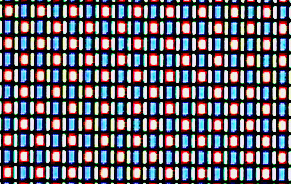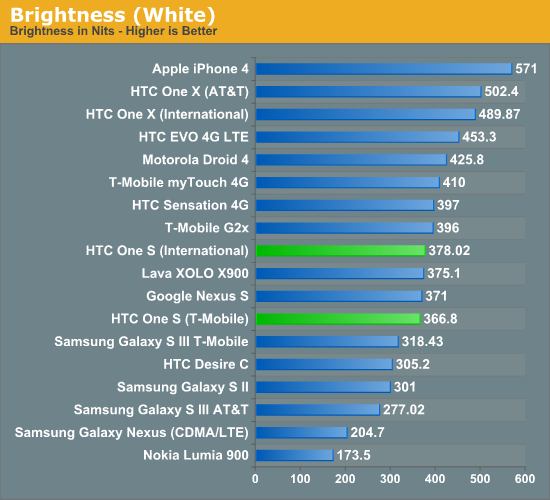HTC One S Review - International and T-Mobile
by Brian Klug on July 17, 2012 9:30 AM ESTThe One S display is a 4.3" SAMOLED panel with qHD (960 x 540) resolution. If that sounds really familiar, it’s because it’s the same as what was in the Motorola Droid RAZR series, including PenTile RGBG.

What’s different, however, is how well HTC has controlled the color temperature and gamma compared to Motorola in the RAZR. As shown in the HCFR galleries below, gamma is pretty close to 2.2 until you get to the high end, and color temperature is pretty close to 6500K, except at the two darkest grey points. This is so much better than any other OEM calibration of an AMOLED panel I’ve taken a look at, which is rather humorous because the panel is undoubtably Samsung’s. HTC is also letting the panel go pretty bright, up past 350 nits, instead of clamping it way down around 200 (I’m looking at you, Galaxy Nexus) to save power. I also haven’t noticed blacks not being totally off on the One S like I have with some others. Of course, colors are still massively oversaturated if your source color space is sRGB.

I’ve griped about PenTile RGBG before on this panel and other SAMOLED displays, but I find the One S to be completely enjoyable in spite of having it thanks to two things. First, how well HTC has controlled the panel (no awful hues, weird white points, or dramatic shifts as you change brightness) - this is basically the best I’ve seen this particular panel, and until SGS3, the best I’ve seen AMOLED in general. Second, because HTC doesn’t appear to be applying any processing that applies sharpening (like Samsung’s mDNIe) to text.
How you feel about PenTile really is the final factor: it’s there, but I’ve slowly become accustomed to it after staring at it for so long. If you go back to the Nexus S days, I was one of the most outspoken critics because of how large those subpixels were. With small enough subpixels (below visual acuity), PenTile starts to make sense. In other news, HTC moving back to Samsung AMOLED for phones is an interesting move after supply issues forced HTC to SLCD with some earlier phones, here on the HTC One S however, it looks great.






















97 Comments
View All Comments
metafor - Tuesday, July 17, 2012 - link
The screens on just about every Android phone of recent has been at least ~40% larger. Add to that the fact that a bunch of them are AMOLED and you pretty much have your answer.sigmatau - Tuesday, July 17, 2012 - link
Bingo, the biggest contribution to battery life is a function of the size.The iphone having the smallest screen of all smartphones on the list should have great battery life. They should be up there with the razr.
Do people really think that their 15" monitor uses the same amount of power as a 55" LCD TV? There is a huge difference.
name99 - Tuesday, July 17, 2012 - link
"Do people really think that their 15" monitor uses the same amount of power as a 55" LCD TV? There is a huge difference."
Don't be too sure of this without checking.
I have a (new) 46" LCD TV and a (four years old or so) 20" monitor, both 1080p. The monitor very clearly runs a lot hotter than the TV, and the specs say it has a higher power draw.
Point is --- engineering details still makes a big difference.
Death666Angel - Thursday, July 19, 2012 - link
You are most likely comparing CCFL vs LED. These phones all have the same background light when they use LCDs.lilmoe - Tuesday, July 17, 2012 - link
it's not only about hardware. iOS isn't as powerful as android, nor does it support full multi-tasking like Android does. when you're browsing on iOS, for example, everything else is in "sleep-mode", while in android, everything else is still running.Android VS WP7 show a clear picture. the Lumia 900 lasts longer than any Android phone using the same SoC, even with LTE turned on.
Android is a double edged sword, it's powerful, yet it can be very power consuming, because of all the processes that work in the background.
Samus - Wednesday, July 18, 2012 - link
1) The iPhone is still a 3G (not even 3.5G) device2) The iPhone has a 3.5" screen, opposed to most Android phones having 4"+ screens.
Obviously iPhone is going to have better battery life.
IKeelU - Tuesday, July 17, 2012 - link
The main differentiator is actually the software. Android devices will always have a very hard time catching up simply because iOS is ridiculously optimized compared to Android.amdwilliam1985 - Tuesday, July 17, 2012 - link
You mean ridiculously limited right?shaolin95 - Wednesday, July 18, 2012 - link
Indeed!apple fanboys have their own replacement words as you noticed :D
Connoisseur - Tuesday, July 17, 2012 - link
Umm... 3.5" screen versus >4" screen? LCD vs SAMOLED? I'm assuming the major differences in battery really just come down to the type and size of screen used. The only way they could do an apples to apples comparison was if someone made a 3.5" LCD Android 4.0 smartphone with a comparable battery to the Iphone 4S.These phones also have DC-HSPA/LTE built in which are probably more power hungry than the 4S HSPA+ baseband.
In short - Higher performance = higher power consumption